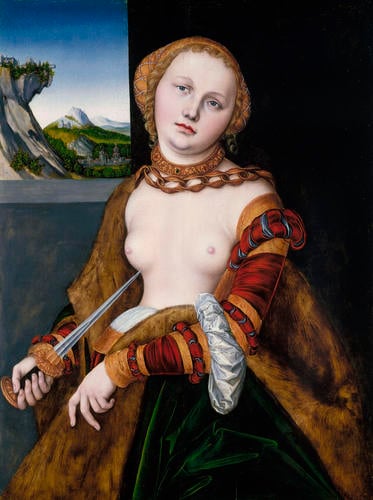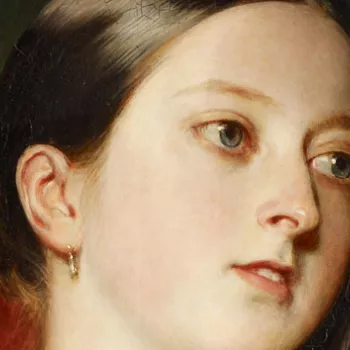Lucretia Dated 1530
Oil on panel | 76.0 x 56.1 cm (support, canvas/panel/stretcher external) | RCIN 400050

Lucas Cranach the Elder (1472-1553) and workshop
Lucretia Dated 1530
-
Lucretia, the virtuous wife of a nobleman, was blackmailed and raped by Sextus Tarquinius. Shamed by the loss of her honour, Lucretia informed her father and husband before stabbing herself (Ovid, Fasti, II, 725-852; Livy, History of Rome, I, 57-9). Her suicide prompted a rebellion which resulted in the foundation of the Roman republic. As the paragon of Roman virtue, Lucretia appears in the bedroom of Sophie of Mecklenburg in Andreas Meinhard’s 1508 description of the decoration of the palace of Wittenberg. She prestigiously adorned the bridal bed in the palace as part of the decorations provided by Cranach and his assistants to celebrate the marriage of the Elector Johann the Steadfast and Margaret of Anhalt, as described in Philip Englebrecht’s poem of 1513.
Of all the secular subjects, this was the one Cranach painted most frequently. Nearly 40 versions are recorded; many of them are half-length with a view through a window to a landscape, as here, or full-length; some show Lucretia completely nude, and in some she is paired with Venus to embody two kinds of love. Lucretia’s patrician status is displayed by her rich clothes and jewellery, though a fur-lined robe was also worn by Venetian courtesans. As in other versions, she is contemplating the act of suicide, but her dagger has not drawn any blood.
In Lucretia Cranach combines the brutal death of a chaste and virtuous heroine with erotic sensuality. Cranach’s figural type is both sophisticated and naive; the anti-classical shape suggests a self-conscious return to the innocent youthfulness and courtly grace of the so-called International Gothic style found around 1400. The simplicity of the nude may also have been a response to Martin Luther’s insistence on simplicity and narrative clarity in visual imagery, which the reformer regarded as the tool for the dissemination of the Word.
Cranach was familiar with Dürer’s work and there is a full-length drawing by Dürer of Lucretia (Albertina, Vienna, 1508). Cranach probably knew paintings of the subject by the Netherlandish Quinten Massys (Museum of Fine Arts, Budapest) and Joos van Cleeve (Kunsthistorisches Museum, Vienna) which date from c.1520-25. Similarities with depictions of the same subject by Francesco Francia (for example, Staatliche Kunstsammlungen Gemäldegalerie, Dresden, c.1505-6) and Giorgione’s Laura (Kunsthistorisches Museum, Vienna) have led to suggestions that Cranach travelled to Venice and Bologna, perhaps in 1509.
This painting is close to a more detailed version dated 1529 (University of Houston Foundation) which is a similar size (73.0 x 53.0 cm). In both paintings the mountainous landscape has the same building jutting out from a rocky outcrop, also found in a landscape fragment (c.1525-30, private collection) and clearly part of the workshop repertoire. Cranach was praised in his own time for being able to paint speedily. He developed a highly efficient system of delegation while maintaining a remarkably high standard of quality with workshop participation, as here. The inclusion of his winged serpent device was not a sign that he had personally painted a picture, but it was a guarantee of high quality.
Prince Albert bought this picture and Cranach's Apollo and Diana (RCIN 407294) in the same year. He framed them almost identically and hung them with others by Cranach and his contemporaries in the Page's Waiting Room at Osborne.
Catalogue entry adapted from The Northern Renaissance. Dürer to Holbein, London 2011Provenance
Purchased by Prince Albert of Mr. Nicholls, May 1844 (LC 1909); Prince Albert's acquisitions 1844 (May 160 No 157, £500, Rough Catalogue No 139)
-
Creator(s)
Acquirer(s)
-
Medium and techniques
Oil on panel
Measurements
76.0 x 56.1 cm (support, canvas/panel/stretcher external)
90.5 x 71.7 x 7.3 cm (frame, external)
Category
Object type(s)
Alternative title(s)
Lucretia stabbing herself, previously entitled









